You never think it is going to happen to you. Especially in Wayne County Ohio. We don’t have bears here, do we? Julie and I went out on Friday afternoon (May 25) to check on our hives and release our new Russian queens from their queen introduction frames. It was a beautiful May day right up to when we pulled up to our first set of hives, then our heart sank.
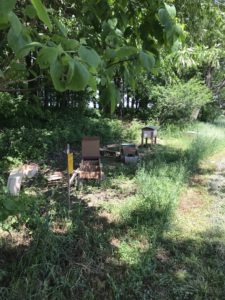
Several of the hives in this set had been knocked over. Obviously this wasn’t how we had left them. We then drove around to our second set of hives at this location, but we only got close enough to see that they had been knocked over too. We went back and looked closer at the first set of hives. At first glance it looked as if someone had run by and flipped over 3 of the 5 hives (one horizontal was already empty, the other 4 hives were new packages we installed in April). I was sure that someone had vandalized our hives. The hay field next to our hives had been mowed so I stopped at the farm to ask when they had mowed, and if they had seen anything. They had mowed the hay two days prior on Wednesday (23rd) and the hired man said he saw the hives then, but thought the wind had just knocked them over. (grrrr). Needless to say I had a talk with that hired hand and informed him that unless a tornado goes through that isn’t likely to happen and to please call me if you see anything like that again. (He definitely isn’t getting a Christmas card from me this year.) I called and talked with my bee inspector to ask if this qualified under the USDA reimbursement program (it doesn’t). Not knowing what we were going to find when we started putting them back together, and how it might, or might not, be covered by our insurance, I called the Sheriff’s office to report it. They sent out an available deputy, that wouldn’t you know it, was highly allergic to bee stings and even carries an Epipen with him! He was a real trooper though and helped us analyze the situation. He did hand his camera to me to get closer pictures of the damage though.
As we were looking over the first set of hives our discussion turned to the black bear that had been seen in the area.
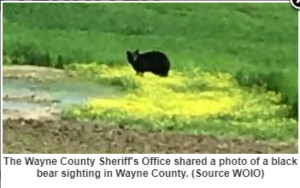
There wasn’t anything that screamed bear when looking at these first hives. In fact there were two frames of brood that were laying on their side in one of the boxes that hadn’t been touched.
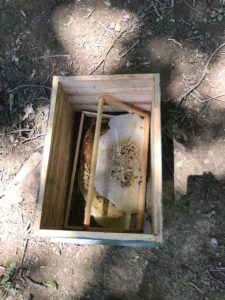
I would have thought a bear would have made short work of those.
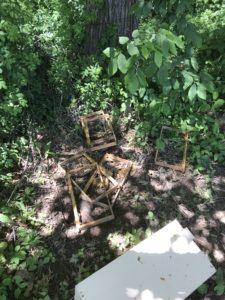
One of the hives had all the frames out and spread from the hive area to several feet into the woods with most of the comb missing. I figured a smaller animal (skunk, racoon, etc.) could have done that.
Another hive had the frames knocked out of it, but four of them stayed somewhat together and the bees were back on them going about their business. Amazing the bear didn’t eat them or other critters find them since they were this way for 3 days.
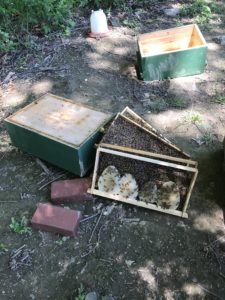
One of our horizontal hives was flipped forward until its’ legs stopped it from going any further.
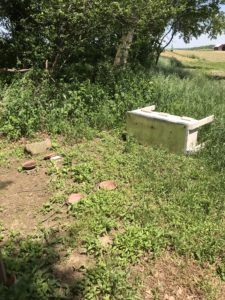
Obviously this wasn’t done by a small animal.
There was one active hive and one empty hive that were left alone in our first set of hives.
We then went to our second set of hives and examined them. It was a similar situation at this second set. 4 of the 5 hives with bees had been knocked over and strewn about. 1 hive with bees and 2 empty hives were not touched.
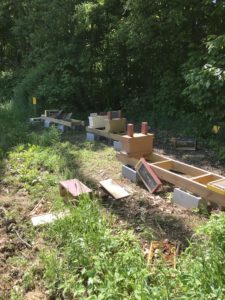
But finally we had a smoking gun as to what was responsible for this mess.
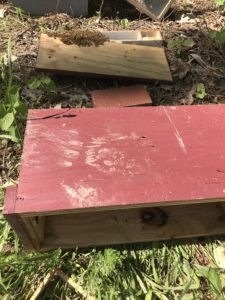
Even though we couldn’t find any clear definitive prints in the ground around the hives, we did get a good bear paw print on the side of this nuc.
Hive parts were strewn all over the place here. There were hive parts and frames 10 feet on one side of the stands to 15 feet and into the woods on the other side. Three of the hives affected were ones that we had just put new Russian queens in introduction frames into a week before. These frames were laying out in the open, one in the woods, but the queens were still alive and there were still worker bees on the frames taking care of the queens. Had we not used these frames, but instead just hung them in the standard queen cage, I’m not sure what the outcome would have been. At the very least the small queen cages would have been much more difficult to find in the woods. As it turned out, none of the frames were damaged and we were able to place them right back in a hive and didn’t lose any of our new queens.
One of the hives here was a double deep nuc that had simply been knocked over, but all the frames were still inside the nuc boxes although wide open on both sides. The bees were still in there, business as usual.
Once we had taken our pictures and looked over the carnage, it was time to start putting things back together and accessing the actual damage.
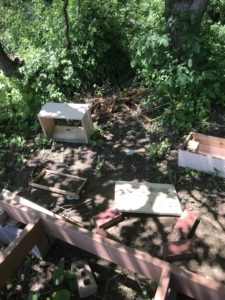
We started with our first set of hives. The first hive here was pretty simple, it was history as far as bees went. All the frames had the comb eaten out and a few were broken from being stepped on or had the support strings (fishing line) broken. There were no bees anywhere on these frames or boxes. This hive was simply assembled and set back up on the stand for future use.
The next hive had the four frames that sat out in the open for 3 days (see picture above). We carefully picked the frames up one at a time and placed them back in the brood box. We found the queen alive and moving around on the combs. So this hive, although reduced in overall numbers from what it had been, was going to be OK. Whew!
We then went to the horizontal hive (horizontal using Langstroth deep frames) and stood it back up on its’ feet and moved it to where it belonged. The bear wasn’t able to get into this hive, not for a lack of trying. Between its’ heavy construction (2×12 lumber body) and the latch holding the lid shut, he didn’t find a way in. There were a few scratches on the aluminum flashing lid from his efforts, but no real damage to the hive. We figured we would find a mess in this hive from it having been flipped over, but when we opened it, all the frames were right where they belonged, the burlap cover was still over top of the frames, and it seemed that all the bees were still there, including the queen who was happily traversing the frames. Another hive that was going to be OK. Woohoo! The lucky thing here is that the hive got flipped completely over so that the entrance was pointing up. Had he simply pushed/pulled it over so that it landed on the front, blocking the entrance (and their ventilation), we might have had a dead hive.
There was one hive with bees in this set that the bear didn’t bother at all. It was more in the middle so maybe he had stirred up such a mess on the first hive that he skipped that one to get away from the angry bees a little. Maybe it was just luck.
So in our first set of hives we had 4 hives with bees, 3 of which were knocked over and apart. 2 of those still had their bees and queens and seemed like they were going to be OK. 1 hive was a total loss as far as bees go. Things could have been a lot worse here.
We now went to the second set of hives to check the damages there. These hives are all nucs. They got scattered around a lot more than the 8-frame Langstroths and the horizontal hive at the first set.
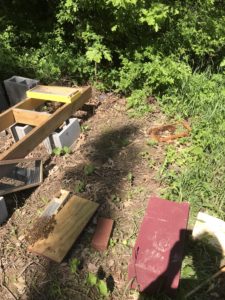
The first nuc we looked at here was spread out for about 10 feet from the stand. The queen introduction frame was laying out in the open beside the lid and a divider board, with bees still covering it. They had taken care of her and she looked to be just fine inside the frame. We reassembled that hive and placed the queen frame back in along with a frame of drawn comb, a frame we salvaged and a division board feeder (since the bear stole all their food). Another hive that appeared to be OK.
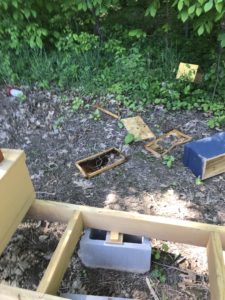
The second nuc was a little more scattered with several parts, including the queen frame, in the woods. The queen was still in the frame and seemed OK. There was a very small amount (less than the size of my fist) of bees on the frame taking care of her. We put the queen frame back in the hive along with a frame of empty comb, a frame with nurse bees from the tipped over hive (talk about that in a minute) to give them more bodies, and a division board feeder. Hopefully they will make it.
We put the third nuc back together. The queen was looking fine and there were bees covering the majority of the queen frame so we put that back in the hive with couple of comb frames that were partially filled along with a division board feeder. This hive looks like it will make it too.
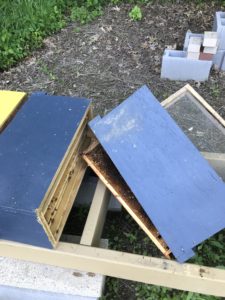
The fourth nuc that got knocked over was one that overwintered this past year (with hardly any stores, but that is a story for another time). It was two deep boxes high and it seems that he just tipped it over. Since it was the most populous nuc in this location, the bees may have come out and chased him away causing him to skip a nuc with bees that wasn’t touched, and move on to the other end of this yard where the previously mentioned nucs were located. We carefully set these boxes back in place and went through the frames until we found the queen motoring around on the comb. We took a frame of nurse bees from this hive and gave it to the second nuc we talked about above. This hive was still looking good so it should make it.
So in our second set of hives we had 5 hives with bees, 4 of which were knocked over and apart. All of them still had at least some of their bees and did have their queens, so it seemed like they were going to be OK. Again, things could have been a lot worse here.
We did look inside the one nuc here that wasn’t bothered. In an interesting turn of events, the bees that we put in with this Russian queen must not have been too eager to accept her as they had raised some queen cells on the frame of brood we put in. These could have been started in the donor hive for this frame and we just missed them when we transfered it to this nuc. We have no way to go back to that original hive to see if there is anything going on as it was the one hive that we lost completely. So we took that frame out and put it into a new nuc along with an empty frame of comb and a division board feeder, and started a new hive.
So assuming that everything is OK moving forward, we had 9 total hives at this location before the bear came through and we now have 9 hives after he came through. We did lose a good number of bodies, and one nuc is a little iffy right now, so that is going to set us back on some of our plans. It seems that our hives were much less like a buffet for this bear and more like a drive though. With as much ground as he was covering in our area, I don’t think he was going to spend too much time in one spot. We can’t complain too much having ended up with as many hives as we started with and not having any more physical damage than we did (we only lost a hand full of frames). We’ve seen pictures of apiaries hit by bear that are littered with busted woodenware. Thankfully that wasn’t us. We will see in a couple weeks if all the surviving hives actually do make it. We’re keeping our fingers crossed.
I am truly hoping this is a one off experience. The sheriff’s office says they get 4-5 reports of bear sightings each year in Wayne County. Seems like a lot to me, I wonder how many are confirmed sightings? It does seem that the bear population is possibly ticking upward a little for Ohio in general. At least according to what you read in the paper and such. I hope in the future they contain their travels to some place other than Wayne County. We could do without having this kind of excitement when going to check our bees.
Glenn and Julie Turner